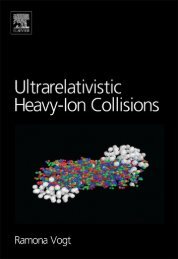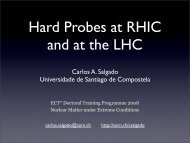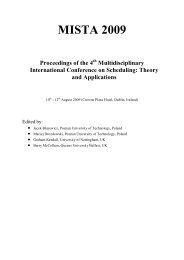Advances in perturbative thermal field theory - Ultra-relativistic ...
Advances in perturbative thermal field theory - Ultra-relativistic ...
Advances in perturbative thermal field theory - Ultra-relativistic ...
You also want an ePaper? Increase the reach of your titles
YUMPU automatically turns print PDFs into web optimized ePapers that Google loves.
Thermal <strong>field</strong> <strong>theory</strong> 385<br />
6. HTL effective action and resummation<br />
As we have seen <strong>in</strong> several examples now, complete weak-coupl<strong>in</strong>g expansions <strong>in</strong> <strong>thermal</strong><br />
<strong>field</strong> <strong>theory</strong> tend to require a reorganization of the standard loop expansion. Already the<br />
<strong>perturbative</strong> expansion of the <strong>thermal</strong> mass (3.8) of a scalar quasi-particle <strong>in</strong> section 3.3 has<br />
shown that ord<strong>in</strong>ary perturbation <strong>theory</strong> fails to determ<strong>in</strong>e higher-order corrections but runs<br />
<strong>in</strong>to IR problems. A resummation of the lead<strong>in</strong>g-order (HTL) mass is necessary (and sufficient<br />
<strong>in</strong> this case) to reorganize the perturbation series [64]. A <strong>thermal</strong> mass ∝ gT <strong>in</strong>troduces an<br />
additional (soft for g ≪ 1) mass scale, and whenever loop calculations receive important<br />
contributions from this scale, it is clearly mandatory to use propagators dressed by these<br />
masses.<br />
In the general case, it is however equally important to <strong>in</strong>clude vertex corrections. In gauge<br />
theories, this is only natural as Ward identities tie up vertex functions with self-energies. But<br />
regardless of gauge symmetry considerations, if there are contributions to N-po<strong>in</strong>t one-loop<br />
vertex functions that are proportional to T 2 like the HTL self-energies, they are as important<br />
as bare vertices when the external momentum scale is ∼ gT . One then has<br />
Ɣ HTL<br />
,N ∼ gN T 2 k 2−N ∼ g N−2 k 4−N ∼ ∂N L cl<br />
∂A N ∣<br />
∣∣∣k∼gT<br />
, (6.1)<br />
for bosonic <strong>field</strong>s A.<br />
A one-loop vertex function whose lead<strong>in</strong>g contribution (for soft external momenta) is<br />
proportional to a power of temperature greater than 1 is called HTL, as this is aga<strong>in</strong> dom<strong>in</strong>ated<br />
by a hard loop momentum ∼T . In fact, already <strong>in</strong> sp<strong>in</strong>or QED there are <strong>in</strong>f<strong>in</strong>itely many HTL<br />
vertex functions, namely those <strong>in</strong>volv<strong>in</strong>g two external fermion l<strong>in</strong>es and an arbitrary number<br />
of gauge bosons. In QCD, there are <strong>in</strong> addition HTLs with an arbitrary number of external<br />
gluons. These have been first identified <strong>in</strong> [279, 213, 280] and used to set up a resummation<br />
programme for amplitudes <strong>in</strong>volv<strong>in</strong>g soft external momenta [213, 281].<br />
6.1. HTL effective action<br />
In the case of scalar φ 4 -<strong>theory</strong>, the only HTL is a mass term correspond<strong>in</strong>g to a local<br />
HTL effective Lagrangian L HTL<br />
scalar<br />
=− 1 2 ˆm2 th φ2 , with ˆm 2 th<br />
the lead<strong>in</strong>g-order term from (3.8).<br />
Remarkably, the <strong>in</strong>f<strong>in</strong>itely many HTL diagrams of gauge theories have a comparatively simple<br />
and manifestly gauge-<strong>in</strong>variant <strong>in</strong>tegral representation [282, 283, 195, 284]:<br />
L HTL = L HTL<br />
f<br />
+ L HTL<br />
g<br />
∫ ∫<br />
= ˆM 2 dv<br />
4π ¯ψγ µ v µ<br />
iv · D(A) ψ + ˆm2 D<br />
2 tr dv<br />
4π F µα v α v β<br />
(v · D adj (A)) F µβ, (6.2)<br />
2<br />
where v = (1, v) is a light-like four-vector, i.e. with v 2 = 1, and its spatial components are<br />
averaged over by ∫ d v ···. Here, v is the remnant of the hard plasma constituents’ momenta<br />
p µ ∼ Tv µ , namely their light-like four-velocity, and the overall scale T has comb<strong>in</strong>ed with<br />
the coupl<strong>in</strong>g constant to form the scale of the <strong>thermal</strong> masses, ˆM, ˆm D ∼ gT .<br />
The covariant derivatives <strong>in</strong> the denom<strong>in</strong>ators of (6.2) are responsible for the fact that<br />
there are <strong>in</strong>f<strong>in</strong>itely many HTLs. Because <strong>in</strong> QED one has D adj (A) → ∂, the only HTL with<br />
exclusively photons as external l<strong>in</strong>es is the photon self-energy polarization tensor; the other<br />
HTL diagrams of QED have two external fermion l<strong>in</strong>es and an arbitrary number of photon<br />
<strong>in</strong>sertions.







